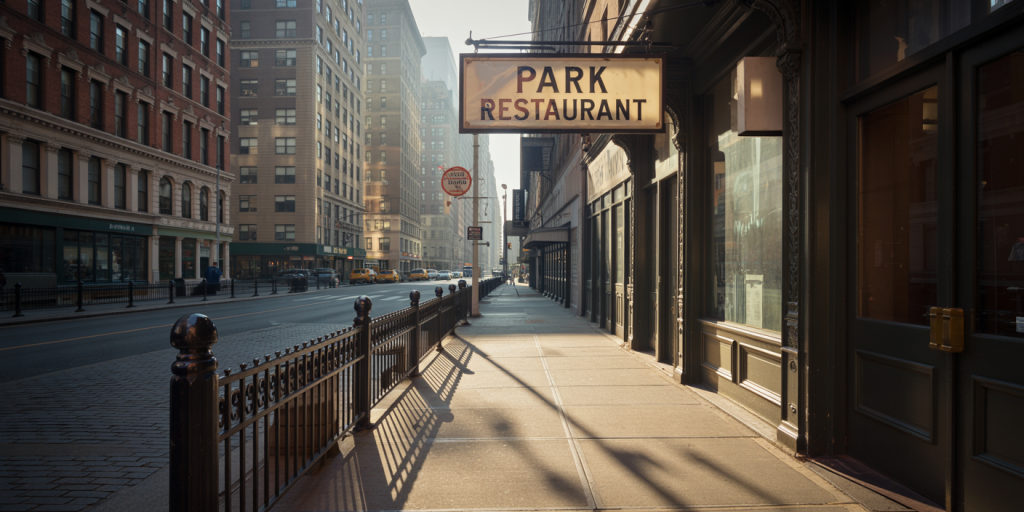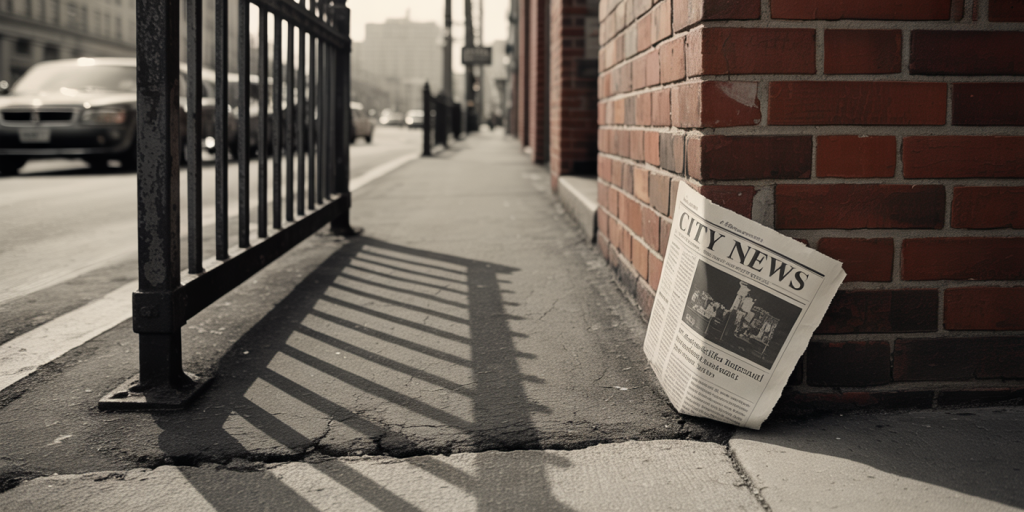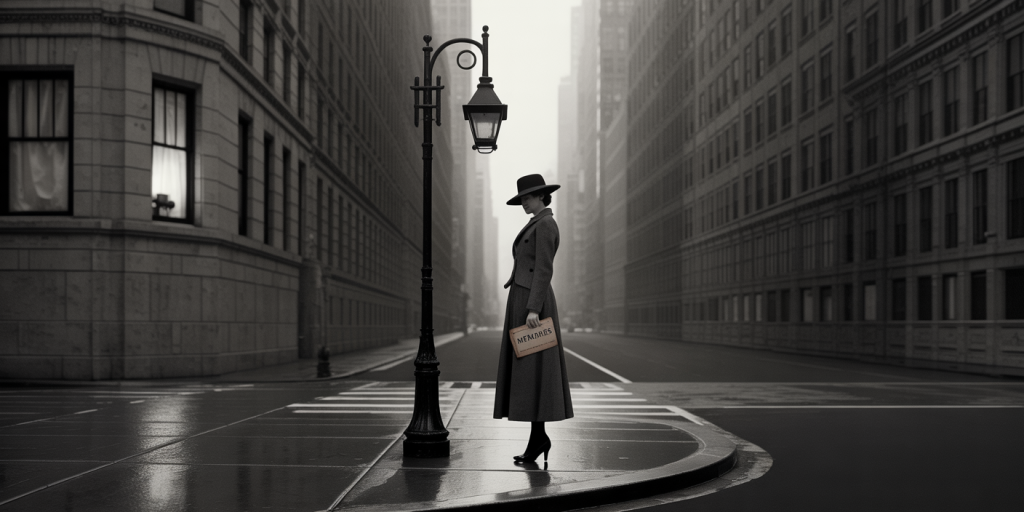Time Pauses on the Sidewalks of Berenice Abbott
Contemplative Opening
There are photographs that do not capture time—they cradle it. In the work of Berenice Abbott, sidewalks are not mere passages, but stages where stillness performs. Every crack in the pavement, every iron railing, every stoop holds a whisper of time not fleeing, but folding. Her lens does not seize the moment—it listens to its breathing.
Abbott’s city is not hurried—it is suspended. The men and women she glimpses may rush, the cars may blur past, but the sidewalks themselves pause. They linger in the frame, calm as memory, solid as silence. She does not document motion—she reveals its absence. She photographs not to remember, but to witness what remains, enduring as brick, alive as shadow.
Table of Contents
- The Echo Beneath the Footstep
- Streets Like Sentences
- The Angle That Observes
- Iron Rails and Dusty Light
- Buildings That Lean Inward
- The Geometry of Stillness
- Facades with Breathing-Skin
- Windows That Contain the Sky
- Fire Escapes as Musical Lines
- Time Folded Into a Shadow
- Stillness in Perspective
- The Threshold Between Public and Private
- Sidewalks as Scrolls of Memory
- Light Spilled Like Milk
- The Vertical Weight of Silence
- Human Figures as Passages
- Textures of the Forgotten
- The Architecture of Restraint
- The Street as Theater
- Final Gestures Etched in Stone
The Echo Beneath the Footstep
Abbott’s sidewalks do not just support—they echo. Each footstep becomes a reverberation in the visual narrative. The ground beneath her camera is not neutral, but intimate. It listens, receives, and records the passage of bodies with silent fidelity.
In her work, the sidewalk becomes witness, not surface. An urban confidant, where each scuff and groove is a chapter in the city’s whispered autobiography.
Streets Like Sentences
Every street corner she photographs is a sentence interrupted mid-thought. A rhythm begins in the curve of a curb, breathes in a fire hydrant, pauses at a lamppost. Abbott constructs visual grammar out of asphalt and angle.
Her camera reads the city as a reader scans a page: slowly, sensing weight in every punctuation mark of space.
The Angle That Observes
Abbott’s compositions often bend, tilt, or elevate not to distort—but to reveal. She stands not at eye level, but at emotional height. From above, a street becomes a vein. From below, a tenement becomes a monument.
Her angles are acts of empathy. She looks as a city might look at itself—patiently, without judgment, with awe.
Iron Rails and Dusty Light
Wrought iron is a recurring character in Abbott’s city—a lace of strength, a barrier that doesn’t divide but frames. In morning light, these rails cast shadows like poems: short, sharp, precise.
The dust, the rust, the chipped black paint—none are blemishes. They are evidence. Evidence of time passing slowly enough to mark.

Buildings That Lean Inward
In Abbott’s vision, buildings do not merely stand—they lean. They incline as if listening, as if bearing the weight of stories on their backs. Their facades are not rigid—they are wrinkled with history.
The city’s architecture becomes an anthology. Each cornice, a stanza. Each lintel, a line. And the buildings, forever leaning, remain unfinished poems.
The Geometry of Stillness
The geometry in Abbott’s photographs is not Euclidean—it is emotional. Lines intersect like crossed arms. Repeating windows create a rhythm that lulls. Perspective becomes a gesture, not a formula.
Stillness becomes structure. A doorway framed in silence. A lamppost standing in slow applause. She teaches us to feel shape—not just see it.
Facades with Breathing Skin
Brick in Abbott’s hands is not hard. It breathes. It peels, it crumbles, it stretches like skin too long in the sun. Her buildings are not structures—they are bodies.
You want to touch the walls in her photographs. To press your palm against them and feel warmth. To feel the breath that architecture can hold.
Windows That Contain the Sky
Her windows are not transparent—they are meditative. They do not open—they hold. In their glass, the sky pauses. The clouds slow. The reflection of a telephone wire becomes a hymn.
Windows become pockets of the infinite. They do not reveal what’s inside—they reveal that even architecture can dream.
Fire Escapes as Musical Lines
The zigzag of a fire escape, in Abbott’s compositions, is never utilitarian. It becomes melody. It cuts across facades like notation, like musical staff. Each landing, a rest. Each stair, a note.
In her city, emergency is beautiful. Even the escape routes have rhythm.
Time Folded Into a Shadow
Abbott captures time not as motion, but as fold. A shadow across a stoop is not absence—it is a presence curled inward. Light doesn’t just land—it lingers. It drapes the past over the present.
And time, in her viewfinder, behaves differently. It doesn’t move forward—it settles.
Stillness in Perspective
Her perspectives are never neutral. A deep vanishing point becomes an inhale. A tilted row of houses exhales. She uses perspective not to organize, but to awaken.
Stillness, in her lens, has depth. You fall into it slowly. You arrive not with the eyes—but with breath.

The Threshold Between Public and Private
Abbott loves the threshold—the step, the stoop, the doorway ajar. It is neither home nor street. It is possibility. Her camera lingers on thresholds the way one lingers before saying goodbye.
These spaces hold tension. The kind that exists before a door closes, before a secret is spoken.
Sidewalks as Scrolls of Memory
To Abbott, the sidewalk is a scroll unrolling memory. Gum stains, scratches, lost gloves—they are not debris, but syllables. The city writes its story not on paper—but beneath our feet.
Her photographs ask us to read the ground. To find history not in monuments, but in gutters and grates.
Light Spilled Like Milk
Light, in her city, is not always dramatic. It’s subtle, like milk tipped from a glass, spilling across brick and soot. It spreads slowly, quietly, creating halos on worn stoops.
Even harsh sunlight becomes gentle. It doesn’t blind—it brushes.
The Vertical Weight of Silence
Skyscrapers rise not with pride, but with weariness. Their windows squint. Their ledges crumble. Abbott doesn’t romanticize them. She reveres their age. Their endurance.
They carry silence upward. A vertical melancholy. A silence so vast it touches sky.
Human Figures as Passages
People, when present, are not subjects but seasons. A woman with a shawl becomes winter. A boy leaning on a hydrant becomes a comma in a long sentence.
They pass. They pause. They remind us that humanity is not decoration—it is punctuation.
Textures of the Forgotten
Dust on a window. Scratches on a tile. Rust on a hinge. Abbott lets forgotten textures rise. Her photography is not restoration—it is recognition.
She allows the overlooked to shine. She honors erosion as evidence of having been touched.
The Architecture of Restraint
Her compositions are never indulgent. They are sparse, restrained. She avoids flourish. She avoids flair. In that restraint lies dignity.
Architecture does not need to shout to matter. A blank wall becomes a chapel. A quiet corner becomes scripture.

The Street as Theater
Her city is not a backdrop—it is stage. A stoop becomes a proscenium. A storefront, a mask. Each photograph is a one-act play, paused at the breath before a line is spoken.
We, the viewers, become audience and actor. We enter the frame through stillness.
Final Gestures Etched in Stone
Every frame ends not with punctuation, but with gesture. A curtain fluttering. A pigeon mid-step. A door half-open. These gestures do not complete the narrative—they extend it.
Abbott knew that the best endings do not resolve—they resonate.
FAQ – Frequently Asked Questions
Who was Berenice Abbott?
Berenice Abbott (1898–1991) was an American photographer known for her documentary photography of New York City architecture and scientific phenomena, blending formal clarity with emotional depth.
What style did she work in?
She worked in a documentary realist style, capturing urban architecture and street scenes with sharp clarity, balanced composition, and poetic stillness.
Why are sidewalks important in her work?
Sidewalks serve as silent witnesses. They ground the frame, carry history, and represent the shared space between personal memory and collective passage.
What technical elements define her photography?
High contrast black and white, precise focus, attention to composition, use of natural light, and careful framing of architectural forms and street elements.
How does her work influence modern photography?
Her ability to transform the mundane into the monumental paved the way for street and urban documentary photography that values form, history, and emotion.
Final Reflections – Sidewalks That Still Whisper
To walk through Berenice Abbott’s photographs is to tread softly through the memory of stone. Her sidewalks are not empty—they murmur. Each crack is a name forgotten. Each step, a breath retained.
She did not freeze time—she invited it to sit. And it did. Still there, in the shadow of a railing. Still waiting. Still whispering.
